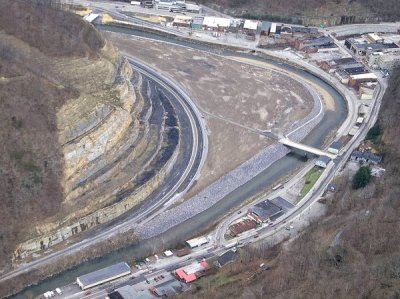

By Lewis Loflin
The image above, sourced from the U.S. Army Corps of Engineers, shows Grundy, Virginia, circa 2005, with the flood control project visible on the left.
A local resident once remarked, “Nothing ever changes here,” a sentiment borne out by Grundy’s ambitious government-funded projects. Initially, after five years of work by 2007 to clear a 13-acre site for a revitalized downtown, officials envisioned a thriving new town. Instead, after relocating 2 million cubic yards of rock and dirt at a cost of up to $200 million, the result was a Wal-Mart Supercenter. With Grundy’s population at approximately 1,100 in 2000, this equates to roughly $182,000 per resident.
This Wal-Mart stands out as the only one in the U.S. built atop a two-story parking garage, a design to maximize the limited 13-acre site. Commonwealth Development Co. of Knoxville, tasked with a $20 million retail complex, required river access, prompting officials to construct a $1.8 million bridge—initially contractor-only as of August 2007. U.S. Rep. Rick Boucher (D-9th) secured $76 million in federal flood control funds, while the Virginia Department of Transportation (VDOT) contributed $33 million to acquire largely vacant properties, plus $25 million for the road project.
The Washington Post reported that many former business owners, compensated generously for their razed properties, opted not to return, sparking criticism across Virginia. A law school student cited convenience—consolidating scattered stores and parking, with the nearest Wal-Mart previously 40 miles away. Yet, the Appalachian School of Law and Pharmacy, both heavily subsidized, reflect the region’s reliance on government economic initiatives with questionable returns. See Appalachian School of Law Shootings.
By September 2015, the Wal-Mart opened, four years behind schedule, atop its taxpayer-funded garage. Claims of “hundreds of new jobs” materialized as roughly 200 positions—modest for a $200 million investment. Associated retail spaces remained largely empty, and Buchanan County’s population, per the U.S. Census, dropped from 24,029 in 2000 to 20,189 by 2020—a 16% decline—continuing a downward trend. The Virginia Coalfield Economic Development Authority (VCEDA) injected $2 million in 2009 for the garage, atop earlier grants and loans, yet economic revitalization remains elusive.
Buchanan County’s median household income, per 2020 Census estimates, hovered around $28,000, with 22% below the poverty line—figures barely shifted since 2007. The bridge, fully opened by 2015, connects to a Wal-Mart that, while convenient, hasn’t stemmed outmigration or job loss. The Appalachian School of Law and College of Pharmacy, despite millions in subsidies, employ fewer than 100 combined, offering little measurable uplift to the broader community.
The Virginia Employment Commission’s 2007 shuffle—relocating jobs to Buchanan County while cutting 50+ positions elsewhere—proved a shell game, not net growth. By 2025, with unemployment claims stabilized post-COVID but federal funding tight, such tactics persist. Grundy’s $200 million “bridge to Wal-Mart” stands as a costly monument to misplaced priorities in a region still grappling with economic stagnation.
Acknowledgment: Thanks to Grok, an AI by xAI, for formatting assistance. The critique and updates are my own, based on historical data and recent observations. —Lewis Loflin